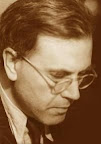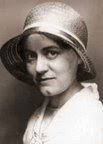The Terrible Reality of Beauty
Barber's "Adagio for Strings, #11" is a beautiful piece. It is deeply gripping, stirring, and evocative. The theme first played at the very start magnifies with intensity at each repetition throughout the piece.
This YouTube video shows a performance of the adagio interspliced with images from the BBC and ABC News. The performance was four days after September 11, and the images are taken from that and subsequent days.
I include this video because it makes an important point in a very tactile way. Ever since the Fall, human history has been the history of exile from the true life God intended for us, our quest to regain it, and ultimately, God's restoration of that life to us when we could not attain it for ourselves. Human history - and each of our lives - is a canvas painted in shades of tragedy and hope, so it is no coincidence that the two themes speak to us so powerfully as individuals and in groups.
Lent is a time during which we are asked by the Church to re-engage these themes in a more profound way: we examine our conscience, we clarify our own limitedness, we touch the wound, prod it, remind ourselves that sin and death are real and at work in our lives.
Suffering, pain, and tragedy aren't all bad though, as the modern world supposes. They are the natural consequence of sin, and aren't to be avoided. They are also the context in which is set all heroism worthy of the name. Sports "heroes" aren't typically heroic at all, but athletic, and we do a great disserve to ourselves and our children who admire them so if we confuse heroism and athleticism. Athleticism is admirable, and even noble, but it has nothing on heroism, and really, fundamentally, is worthless except as a training ground for heroism.
Heroism might be best described, in my thinking, as entering into the lion's den. A heroic man or woman feels fear and pain, sins and dies - but does not let these little tragedies interfere with hope. The hope in question varies from context to context. It may be hope that "it will all work out for the best," or hope that a life might be saved, or that a person might be brought to know the love of Christ. Fundamentally, all these hopes are tied into the object of our highest hope - the hope of eternal life in blessed, joyful union with God. It is this hope that instills true meaning in the lesser hopes, and it is all these hopes that make our hearts soar in the midst of tragedy. Hope fuels heroism. Who is left unmoved remembering Lenny Skutnik,* who swam into the frozen waters of the Potomac to save a stewardess trapped freezing to death in the wreckage of a Florida Airlines Flight 90?
Or more recently, the firefighters who went into the burning towers on September 11?
The terrible reality is that sorrow and beauty are often intermingled - maybe even, to some extent, necessarily intermingled in this age we live in, the Age of the Cross. A project, like that of the Enlightenment, to uproot the one will inevitably uproot the other with it. It is much better, perhaps, to simply train for the one and create the other. So while we continue to wait in joyful hope for the Resurrection, it is important to touch bases from time to time with suffering, sin, and death. In the Church, we call the forty days allotted for this purpose, "Lent."
*(For those of you who don't know about Lenny Skutnik, you can see the story on YouTube, of course, by clicking here. In brief, when rescue efforts failed to save Priscilla Tirado from the Potomac, he dove into the freezing waters and pulled her out, at immense risk to himself and without guarantees for her.)
























No comments:
Post a Comment